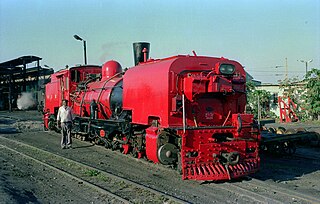
The British Railways Standard Class 9F 2-10-0 is a class of steam locomotive designed for British Railways by Robert Riddles. The Class 9F was the last in a series of standardised locomotive classes designed for British Railways during the 1950s, and was intended for use on fast, heavy freight trains over long distances. It was one of the most powerful steam locomotive types ever built for British Railways, and successfully performed its intended duties. The class was given the nickname of 'Spaceships', due to its size and shape.

The Hunslet Engine Company is a locomotive-building company, founded in 1864 in Hunslet, England. It manufactured steam locomotives for over 100 years and currently manufactures diesel shunting locomotives. The company is part of Ed Murray & Sons.

The LSWR N15 class was a British 2–cylinder 4-6-0 express passenger steam locomotive designed by Robert Urie. The class has a complex build history spanning three sub-classes and eight years of construction from 1918 to 1927. The first batch of the class was constructed for the London and South Western Railway (LSWR), where they hauled heavy express passenger trains to the south coast ports and further west to Exeter. After the Lord Nelsons, they were the second biggest 4-6-0 passenger locomotives on the Southern Railway. They could reach speeds of up to 90 mph (145 km/h).

The SR West Country and Battle of Britain classes, collectively known as Light Pacifics or informally as Spam Cans, are air-smoothed 4-6-2 Pacific steam locomotives designed for the Southern Railway by its Chief Mechanical Engineer Oliver Bulleid. Incorporating a number of new developments in British steam locomotive technology, they were amongst the first British designs to use welding in the construction process, and to use steel fireboxes, which meant that components could be more easily constructed under wartime austerity and post-war economy.

The Hunslet Austerity 0-6-0ST is a class of steam locomotive designed by Hunslet Engine Company for shunting. The class became the standard British shunting locomotive during the Second World War, and production continued until 1964 at various locomotive manufacturers.
The blastpipe is part of the exhaust system of a steam locomotive that discharges exhaust steam from the cylinders into the smokebox beneath the chimney in order to increase the draught through the fire.

The DRB Class 50 is a German class of 2-10-0 locomotive, built from 1939 as a standard locomotive (Einheitsdampflokomotive) for hauling goods trains. It had one leading axle and five coupled axles and was one of the most successful designs produced for the Deutsche Reichsbahn.

The New South Wales C36 class was a class of two-cylinder, simple, non-condensing, coal-fired superheated, 4-6-0 express passenger steam locomotives built by Eveleigh Railway Workshops and Clyde Engineering for the New South Wales Government Railways in Australia.
Adolph Giesl-Gieslingen was an Austrian locomotive designer and engineer.
Córas Iompair Éireann No. CC1, generally known as the Turf Burner, was a prototype 0-6-6-0 articulated steam locomotive designed by Oliver Bulleid to burn turf and built at CIÉ's Inchicore Works in Dublin. CC1 shared some, but not all, of the characteristics of Bulleid's previous attempt to develop a modern steam locomotive, the Leader. Like the one completed Leader, CC1 had a relatively short career and was never used in front-line service. It was the last steam locomotive to be constructed for an Irish railway.
The Lemaître exhaust is a type of steam locomotive exhaust system developed by the Belgian engineer Maurice Lemaître.

The chimney is the part of a steam locomotive through which smoke leaves the boiler. Steam locomotive exhaust systems typically vent cylinder exhaust through the chimney to enhance draught through the boiler. Chimneys are designed to carry exhaust steam and smoke clear of the driver's line of sight while remaining short enough to clear overhead structures. Some chimneys included features to avoid dispersing sparks.

The steam locomotive exhaust system consists of those parts of a steam locomotive which together discharge exhaust steam from the cylinders in order to increase the draught through the fire. It usually consists of the blastpipe, smokebox, and chimney, although later designs also include second and third stage nozzles.

Edward Thomas is a narrow gauge steam locomotive. Built by Kerr Stuart & Co. Ltd. at the California Works, Stoke-on-Trent in 1921, it was delivered new to the Corris Railway where it ran until 1948. After that railway closed, the locomotive was brought to the Talyllyn Railway in 1951, then restored, and remains in working order at the heritage railway. It has carried the operating number 4 under four successive owners.

The Alfred County Railway Class NG G16A 2-6-2+2-6-2 of 1989 is a steam locomotive from the South African Railways era.

The W. G. Bagnall New Standard 180-6-0ST is a type of industrial steam locomotive manufactured at W. G. Bagnall's Castle Engine Works and designed by Harold Wood at W.G. Bagnall in 1951. The class was specifically designed for the Port Talbot Steelworks, and ran from 1951 to 1973 in industrial service. Two locomotives, the former Longbridge locomotives, are preserved.
An industrial steam locomotive is a type of steam locomotive which primarily ran on industrial railways to serve a company by transporting or assisting the manufacturing products of that particular company's produce. Industrial railways often transported items such as coal, iron, slate and workers to aid production. In many countries, industrial steam serving coal mines in particular, lasted significantly longer than the nations otherwise mainline steam traction, due to the readily available fuel.

A double chimney is a form of chimney for a steam locomotive, where the conventional single opening is duplicated, together with the blastpipe beneath it. Although the internal openings form two circles, the outside appearance is as a single elongated oval.

















